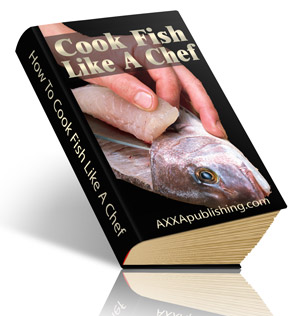How to Cook Fish : E-Book summary and Free download
This briefing document summarizes the main themes and important ideas presented in the provided excerpts from “How to Cook Fish.” The document highlights the extensive scope of the cookbook, the author’s perspective on fishing and cooking, and the detailed instructions for preparing a wide variety of fish and sauces.
Main Themes
1. Comprehensive Guide to Fish Preparation:
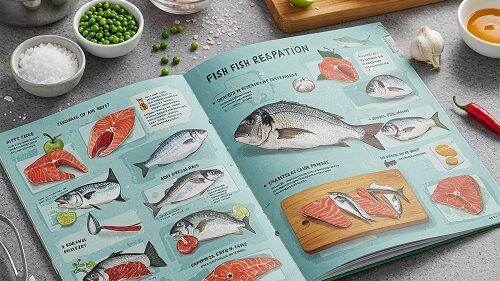
The most striking aspect of this cookbook is its sheer breadth in covering numerous types of fish and offering an astonishing number of cooking methods for each. The table of contents alone lists over forty different types of “unshelled fish” with dedicated chapters outlining multiple ways to prepare them. For example, there are “FORTY-FIVE WAYS TO COOK BASS,” “EIGHTY WAYS TO COOK HALIBUT,” and an impressive “ONE HUNDRED AND THIRTY WAYS TO COOK SALMON.” This highlights the author’s intention to provide an exhaustive resource for fish cookery.
2. Emphasis on Sauces and Accompaniments:

Beyond simply cooking the fish itself, the book dedicates significant attention to sauces and other accompaniments. Chapter IV features “ONE HUNDRED SIMPLE FISH SAUCES,” showcasing the importance of enhancing the flavor of fish dishes through various culinary creations. The inclusion of a chapter on “TEN WAYS TO SERVE ANCHOVIES” further emphasizes the role of flavorful additions.
3. The Art and Science of Fish Cooking:
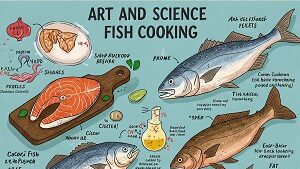
The author positions fish cooking as an art form that can be mastered through the application of “scientific principles.” This suggests a methodical and detailed approach to the recipes, implying that success in the kitchen is achievable by following the provided instructions carefully.
“The cooking, in unskilled hands, is also a lottery, but, by following the appended recipes, becomes an art to which scientific principles have been faithfully applied.” [Page 5]
4. Juxtaposition of the Experience of Fishing and Cooking:

The introduction offers a somewhat philosophical perspective on the act of catching fish versus the act of cooking it. While acknowledging that catching fish is largely a matter of “luck,” the author asserts that cooking, when done correctly, transcends chance and becomes a skillful endeavor. There’s a romanticism associated with the angler’s experience, contrasted with the methodical nature of cooking.
“Yet, when all is said and done, the catching of fish is a matter of luck–a gambler’s chance, if you will have it so.” [Page 4]
5. Detailed and Specific Recipes:
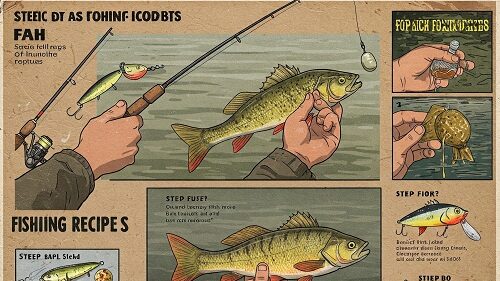
The excerpts from the recipe sections demonstrate a highly detailed and specific approach to cooking. Recipes often include precise measurements, specific ingredients (e.g., different types of stock, wine, herbs), and explicit instructions on techniques (e.g., frying in deep fat, simmering, basting frequently). The variety within the recipes for a single type of fish is also notable, showcasing different culinary influences and flavor profiles (e.g., “BASS A LA BORDELAISE,” “BLACK BASS A LA MONTMORENCY”).
6. Inclusion of Basic Culinary Techniques:
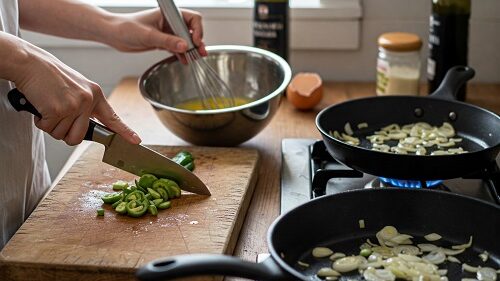
The book covers fundamental culinary techniques such as making court bouillons (flavored poaching liquids) and various base sauces (like Drawn-Butter Sauce and Spanish Sauce) that serve as foundations for more complex preparations. This suggests that the book aims to be educational, providing readers with the building blocks of fish cookery.
Most Important Ideas and Facts
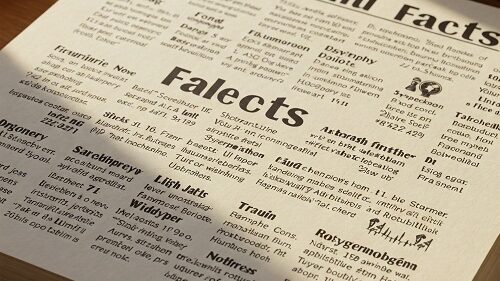
- Atomic Habits Review: Easy & Proven Way to Build Good Habits & Break Bad Ones
- Conversion Boost Special Report : Summary and Download EBook
- Weight Loss And Management Goals : Summary and Download EBook
- Bird Watching Past Times : Summary and Download EBook
- Fad Diet Fiascos : Summary and Download EBook
- Vast Number of Recipes: The sheer quantity of recipes for each type of fish indicates a deep exploration of the culinary possibilities of seafood. This suggests that the book caters to both novice and experienced cooks looking for variety and new ideas.
- Seasonal Considerations: The inclusion of a chapter titled “FISH IN SEASON” hints at an awareness of the best times to procure and cook different types of fish for optimal flavor and quality, although the specifics of which fish are in season at what time are not provided in these excerpts.
- Emphasis on Fresh Ingredients: Many recipes call for fresh herbs, freshly grated ingredients (like horseradish), and specific types of fats (like butter and olive oil), highlighting the importance of quality ingredients in achieving flavorful results.
- Global Culinary Influences: The names of many recipes (e.g., “ITALIAN SAUCE,” “JAPANESE SAUCE,” “FLOUNDER A LA FRANCAISE”) suggest a wide range of culinary influences, indicating that the book draws inspiration from international cuisines.
- Structure and Organization: The detailed table of contents provides a clear structure for navigating the book, allowing readers to easily find recipes for specific types of fish or sauces.
- “Back Talk” Section: The brief mention of a “BACK TALK” section where the author acknowledges the possibility of even more ways to cook fish adds a touch of humility and invites further culinary exploration.
Notable Quotes
- (On the guide’s poor fishing experience): “In the forty years that the guide has lived in the place, man and boy, he has never known the fishing to be as poor as it is now.” [Page 3] This sets a contrast with the abundance suggested by the numerous recipes.
- (On the allure of fishing): “He who has heard the line sing suddenly out of his reel, and, after a hard-fought hour, scooped a six-pound black bass into the landing net, weary, but still ‘game,’ is not dismayed by bad luck.” [Page 4] This captures the passion of the angler.
- (On a simple, yet satisfying fish preparation): “…a pompano will taste half as good as the infantile muskellunge, several pounds under the legal weight, fried unskilfully in pork fat by a horny-handed woodsman, kneeling before an open fire, eighteen minutes after you had given up all hope of having fish for dinner…” [Page 5] This anecdote suggests that sometimes the simplest, most unexpected preparations can be the most delightful.
- (Example of detailed sauce instructions): “To one cupful of Spanish Sauce add two tablespoonfuls of prepared horseradish, two tablespoonfuls of bread-crumbs, a teaspoonful of powdered sugar, and salt, pepper, and made mustard to season. Heat in a double-boiler, and just before serving add one-half cupful of whipped or cold cream. (Cow cream, not cosmetic.)” [Page 27] This illustrates the level of detail in the sauce recipes.
- (Example of specific fish cooking instructions): “Clean, scale, and fillet a haddock. Season with pepper and salt, dip into egg and crumbs and fry brown in deep fat.” [Page 162] This is a typical example of the straightforward yet precise instructions provided.
